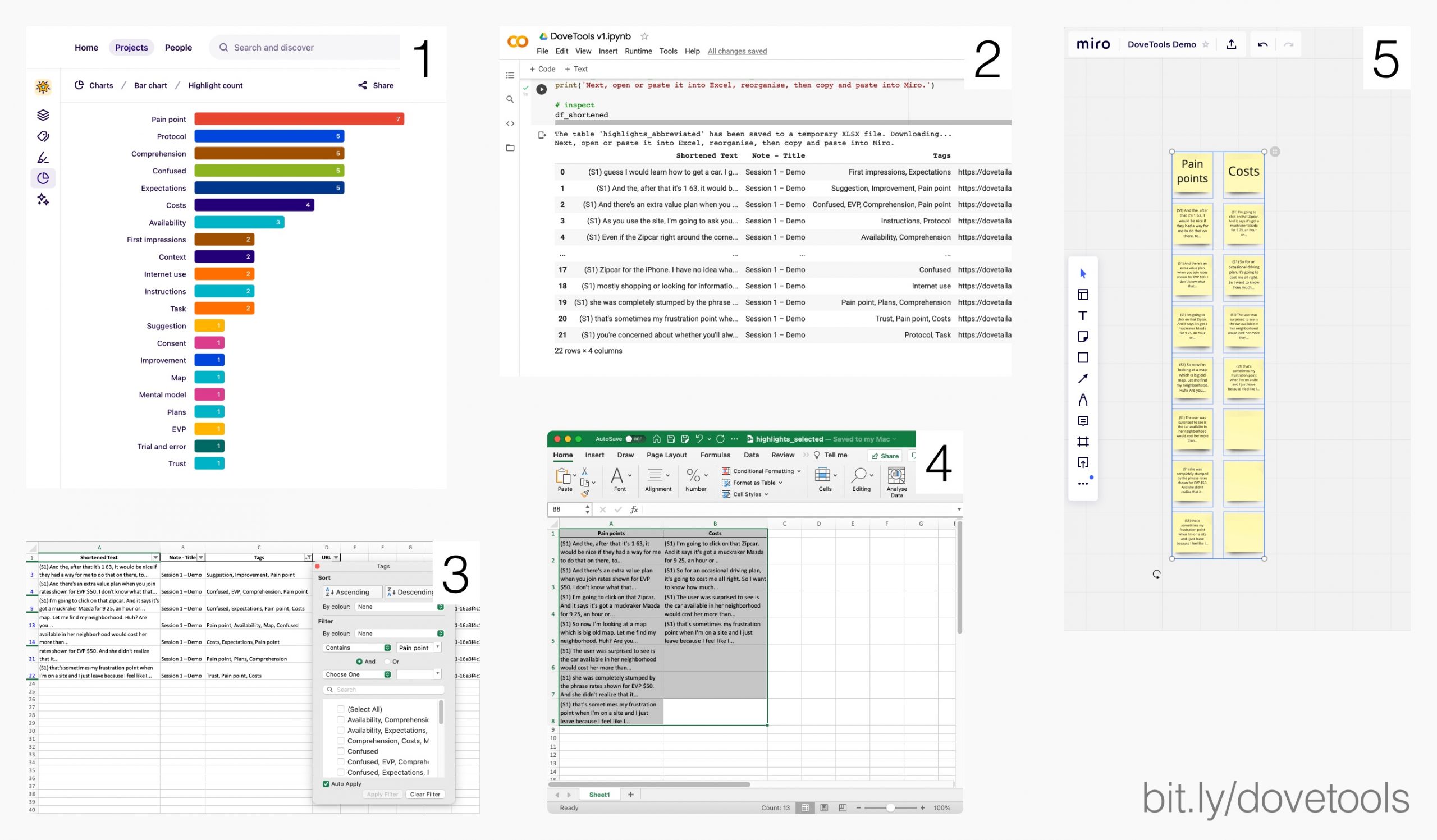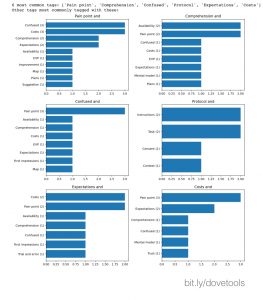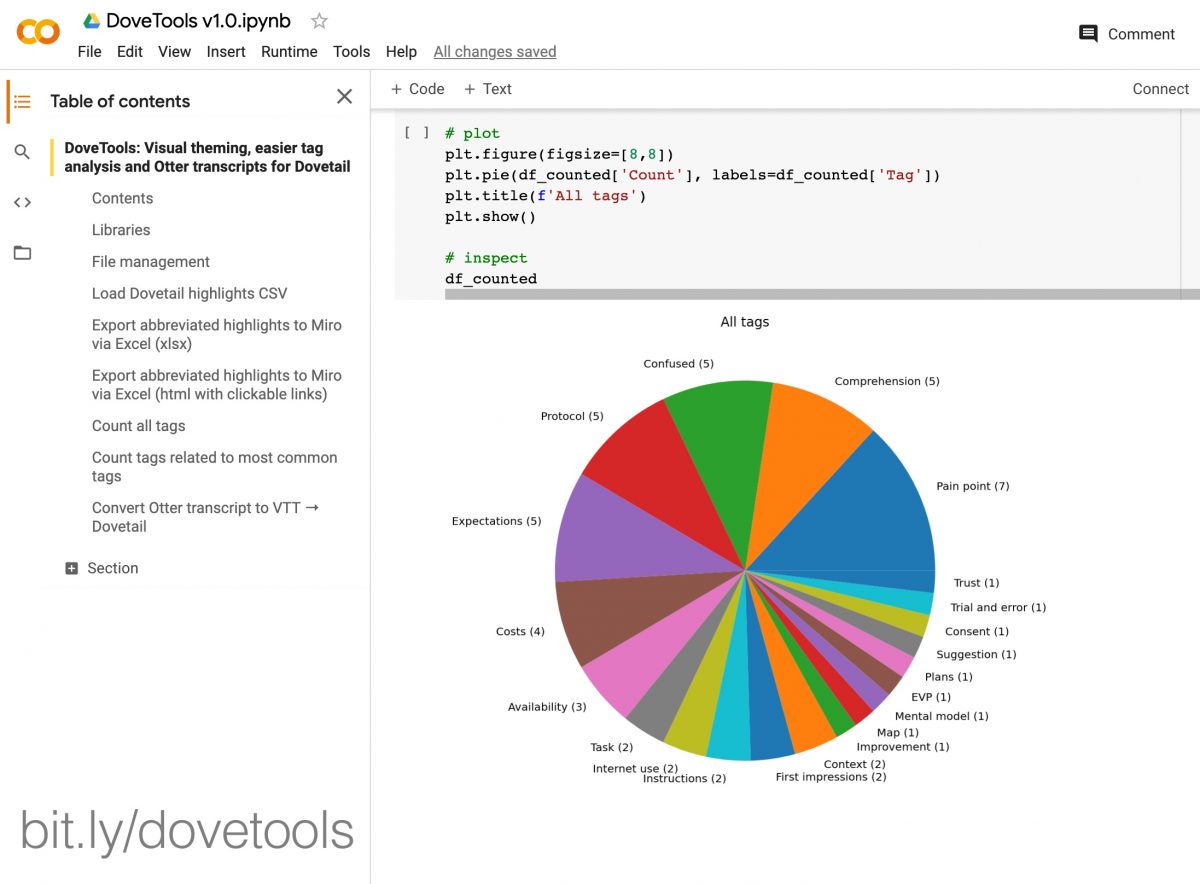I have been using Dovetail extensively on several projects recently and it is an amazing product. Compared to the traditional manual methods, it is a game-changer for collating, highlighting, analysing, and sharing qualitative design research.
I have refined my qualitative research workflow over time and Dovetail is a great addition to my toolkit. However, there are few areas in the product that could be improved to further streamline my workflow. To this end, I have put together a collection of tools called DoveTools.
DoveTools is Jupyter Notebook written in Python and available on Google Colab. It is an open source project hosted on GitHub and released under the MIT license.
👉 Use DoveTools on Google Colab
In its current form, DoveTools includes three main tools:
- Export abbreviated highlights to Miro via Excel, for visual theming and affinity diagramming
- Analyse tag relationships and see other common tags against the most frequent tags
- Otter-to-VTT converter that allows importing Otter.ai transcripts into Dovetail
I will discuss these briefly in the sections below.
Table of Contents
Export abbreviated Dovetail highlights to Miro for visual theming and affinity diagramming
Dovetail allows you to create, view and search transcripts, highlights and tags in very powerful ways. What it does not currently have is a whiteboard feature for organising information visually across a canvas.
The DoveTools ‘Export abbreviated highlights’ feature allows you the abbreviate the text in each highlight and easily copy then into Excel and then further into Miro. I often use this as an interim step in my research workflow to organise and analyse participant quotes before starting to formulate insights.

Analyse Dovetail tag relationships and see other common tags against the most frequent tags
In my research workflow, I typically tag interview sessions soon after running them, creating and applying tags relatively organically. I often group tags iteratively as a proceed through the sessions, and then review them again completing all the sessions.
A great tip from one of my colleagues is to always apply multiple tags to each highlight. This may not be intuitive at first, but it allows you to keep tags ‘atomic’, or normalised, and reduces duplication. Furthermore, it allows you to explore and discover tag relationships in the data later on.
The built-in Charts feature in Dovetail is very limited. It only allows you to view tag frequency and there is no filtering or multi-tag analysis.
The DoveTools ‘Count tags’ feature allows you to analyse tag relationships and see other tags that are frequently tagged together with the most common tags. I find this useful in exploring questions like ‘what are the most common pain points’ and ‘what works well’, and seeing the next level of associated tags. Here’s what this looks like:

Otter to VTT converter for importing Otter.ai transcripts into Dovetail
On a recent project, our client had an existing license for the Otter.ai automated transcription service. To make sure all original transcripts were centrally stored, we ended up using Otter for all transcription. But how to get Otter transcripts into Dovetail?
DoveTools can take an Otter transcript exported in text format and convert it into a Web Video Text Tracks format (VTT). A VTT transcript can be imported into Dovetail for highlighting and annotation, similar to a Dovetail-produced transcript. The one limitation is that VTT-imported transcript only allow playback tracking on a block (quote) level, rather than word-by-word, however in practice this is rarely an issue.
Generally, it appears that Otter transcription quality is on par with the built-in Dovetail functionality. The same goes for matching and amending speakers, a feature that has markedly improved in the most recent Dovetail release.

In closing
I am hoping that by releasing DoveTools as an open source project, the makers of Dovetail are compelled to incorporate some of this functionality directly into their product. This would make these improvements more accessible to all Dovetail users.
I welcome contributions to the project, and I hope you find DoveTools useful in your work. Please let me know if you do!
👉 Use DoveTools on Google Colab
Video walkthrough
In this video I show you how to use the DoveTools notebook and cover its key features, and also share some of my qualitative research workflow:
Credits
Steve Krug is one of the pioneers of user experience and his great book Don’t make me think (2000) was one of my early introductions to the field. His later book Rocket Surgery Made Easy (2009) is a hands-on guide for finding and fixing usability problems.
The Demo Usability Test I have tagged and highlighted in Dovetail as example content in DoveTools is a companion video to the latter book. Steve Krug has very kindly granted me permission to refer his work this way – thank you Steve!
